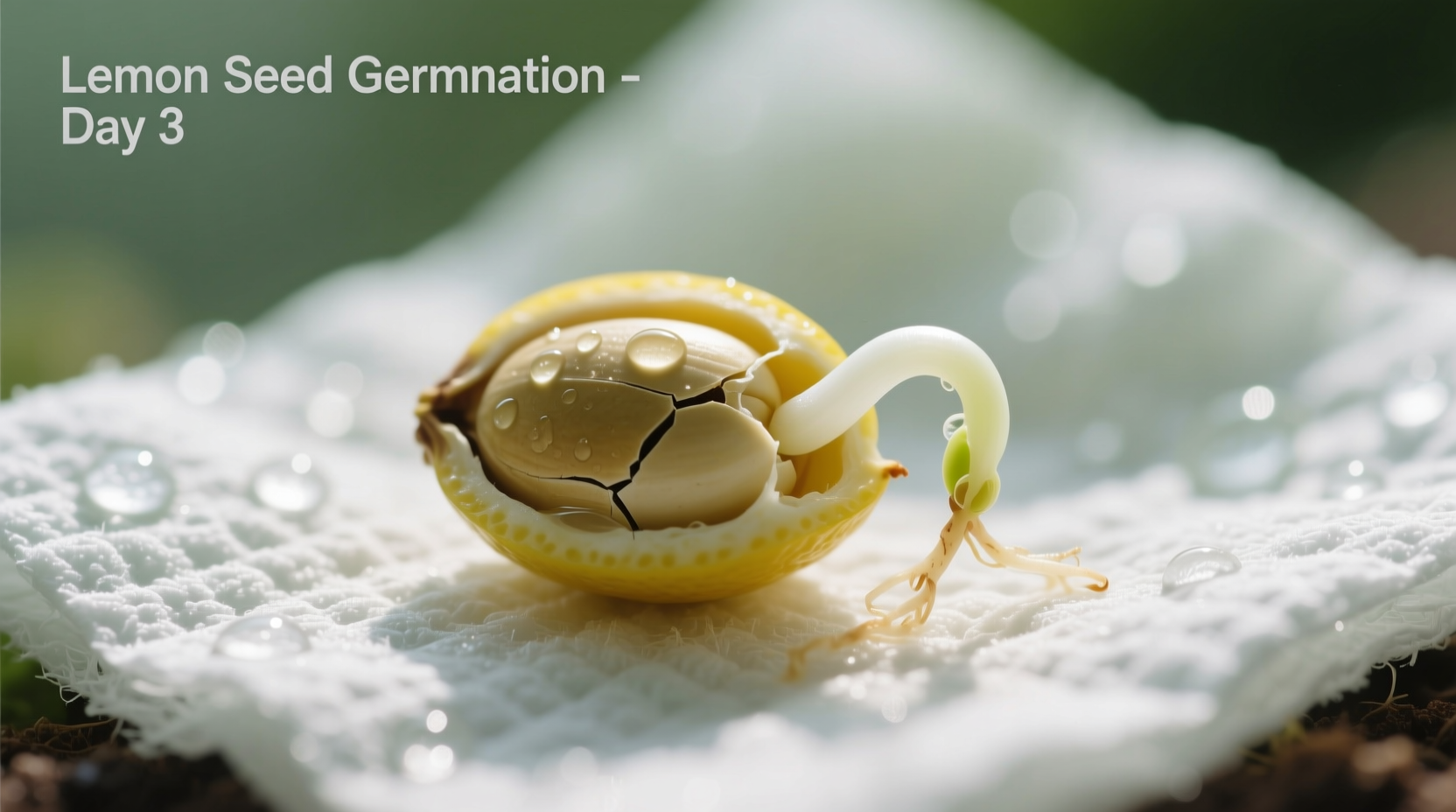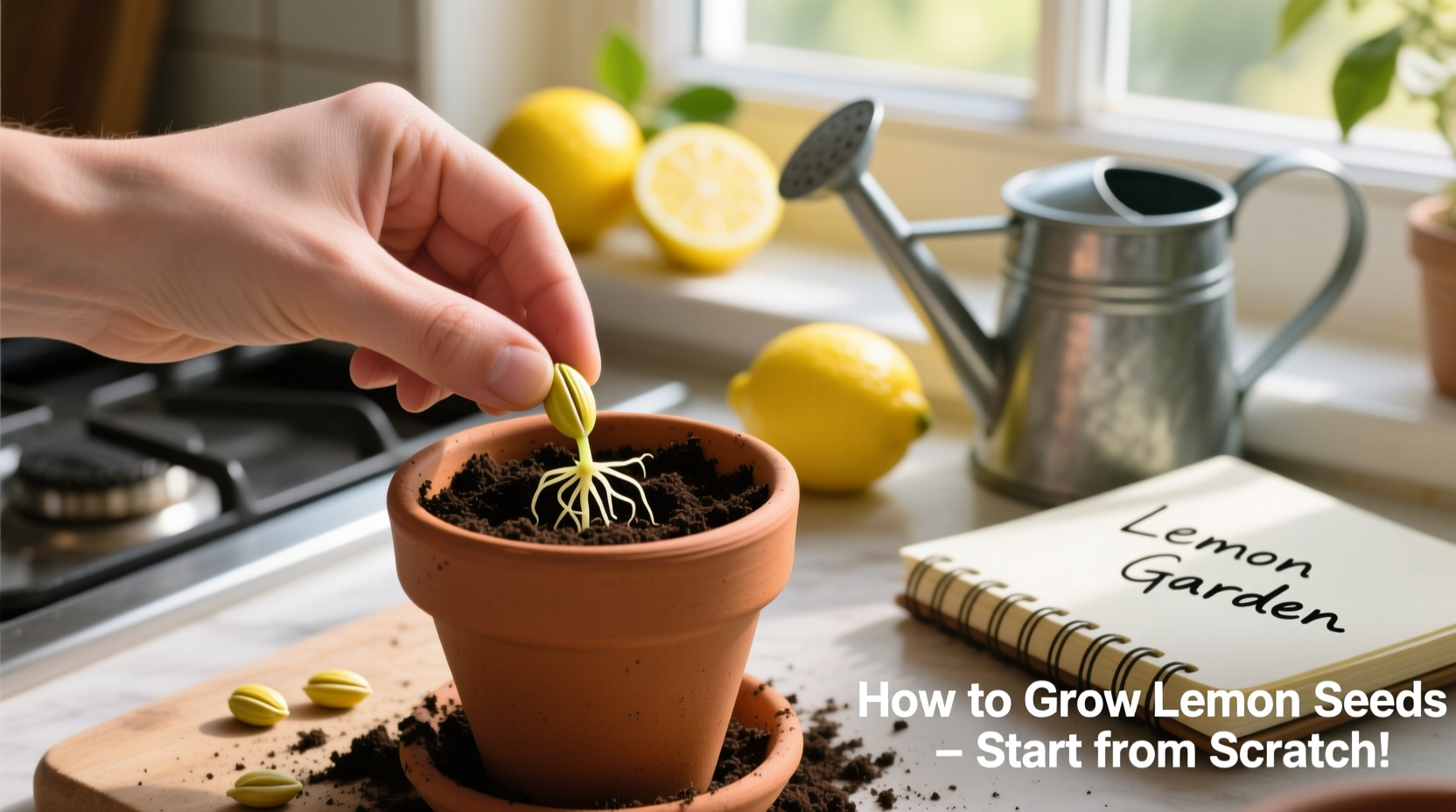Have you ever wondered if those seeds from your grocery store lemon could actually grow into a fruit-bearing tree? While growing lemon trees from seeds won't give you identical fruit to the parent and takes patience, it's a rewarding project that connects you with nature's lifecycle. This guide provides the exact steps professional horticulturists use to maximize your success rate with home lemon seed propagation.
What You'll Need to Start Growing Lemon Seeds
Before diving into the process, gather these essential supplies. Using quality materials significantly increases your germination success rate compared to improvised alternatives.
- Fresh lemon seeds (preferably from organic, untreated fruit)
- Seed starting mix or well-draining potting soil
- Small pots with drainage holes (3-4 inch diameter)
- Clear plastic bags or humidity domes
- Grow lights or sunny south-facing window
- Misting spray bottle
- Small containers for seed soaking
Step-by-Step Lemon Seed Germination Process
1. Selecting and Preparing Quality Seeds
Not all lemon seeds will germinate successfully. Choose plump, firm seeds from ripe fruit—avoid shriveled or discolored specimens. The University of California Agriculture and Natural Resources recommends using seeds from organic lemons when possible, as conventional lemons may have been treated with growth inhibitors (UC ANR Publication 8200).
Immediately rinse seeds under cool water to remove all pulp, which contains germination inhibitors. Don't let seeds dry out—plant within 24 hours for best results. Soak seeds in room temperature water for 8-12 hours before planting to soften the seed coat.
2. Germination Methods: Paper Towel vs. Direct Planting
You have two reliable options for starting lemon seeds:
Paper Towel Method (Recommended for Higher Success Rate)
- Moisten a paper towel (not soaking wet)
- Place seeds on half the towel, fold over
- Put in sealed plastic bag, label with date
- Store in warm location (70-85°F / 21-29°C)
- Check daily for mold or drying out
- Transplant when root is 1-2 inches long
Direct Planting Method
- Fill small pots with moist seed starting mix
- Plant seeds 1/2 inch deep
- Cover with soil, water gently
- Cover pots with plastic to maintain humidity
- Place in warm location with indirect light
The paper towel method gives you better visibility of germination progress and allows you to select only viable seeds for planting, reducing wasted space and resources.

3. Planting Germinated Seeds
Once your seed has sprouted a root (radicle), it's time for planting:
- Fill small pots with well-draining potting mix
- Create a 1-inch deep hole
- Place seed with root pointing down
- Cover gently with soil
- Water thoroughly but gently
- Cover with plastic to maintain humidity
Maintain consistent moisture—never let the soil dry out completely, but avoid waterlogging. Place in warm location with bright, indirect light until the seedling emerges (typically 1-3 weeks).
Lemon Seedling Growth Timeline
Understanding the realistic timeline prevents premature disappointment. Here's what to expect when growing lemon seeds:
| Time Period | Development Stage | Care Requirements |
|---|---|---|
| 1-3 weeks | Germination | Warmth (70-85°F), high humidity, consistent moisture |
| 1-2 months | Seedling emergence | Bright indirect light, careful watering, humidity gradually reduced |
| 2-6 months | True leaf development | Direct sunlight (4-6 hours daily), regular watering, balanced fertilizer |
| 6-12 months | Established sapling | Full sun, regular watering, monthly citrus fertilizer, repotting as needed |
| 3-6 years | First flowering and fruiting | Consistent care, proper pruning, protection from cold temperatures |
Common Lemon Seed Growing Challenges and Solutions
Damping Off Disease
This fungal condition causes seedlings to collapse at soil level. Prevent it by:
- Using sterile seed starting mix
- Avoiding overwatering
- Providing good air circulation
- Using a small fan near seedlings
Leggy, Weak Growth
Insufficient light causes elongated, weak stems. Fix this by:
- Providing 12-16 hours of bright light daily
- Rotating pots regularly for even growth
- Using supplemental grow lights during winter months
Yellowing Leaves
This indicates potential nutrient deficiencies. Address it by:
- Using a balanced citrus fertilizer every 4-6 weeks during growing season
- Ensuring proper soil pH (6.0-7.5)
- Avoiding overwatering which impairs nutrient uptake
When Growing Lemon Seeds Makes Sense (And When It Doesn't)
While growing lemon trees from seeds is educational and satisfying, it has limitations you should understand before starting:
- Best for: Educational projects, decorative houseplants, rootstock for grafting, or if you enjoy the growing process itself
- Not ideal for: Reliable fruit production, specific variety replication, or quick results
Lemon trees grown from seed typically take 3-6 years to produce fruit, and the fruit may differ from the parent due to genetic variation. The University of Florida IFAS Extension notes that "seedling citrus trees are highly variable and may not produce fruit of the same quality as the parent tree" (UF IFAS Citrus Propagation Guide).
If your primary goal is fruit production, consider purchasing a grafted dwarf lemon tree, which can produce fruit in 1-2 years. However, growing from seed remains an excellent way to create rootstock for future grafting projects or simply enjoy the process of nurturing a plant from its earliest stages.
Long-Term Care for Your Lemon Tree
Once established, your lemon tree needs consistent care to thrive:
- Light: Minimum 6-8 hours of direct sunlight daily
- Water: Keep soil consistently moist but not soggy; reduce in winter
- Fertilizer: Citrus-specific fertilizer every 4-6 weeks during growing season
- Temperature: Protect from temperatures below 50°F (10°C)
- Repotting: Every 1-2 years in spring, moving to container 2 inches larger
- Pruning: Remove dead wood and crossing branches; minimal shaping
During summer months, gradually acclimate your tree to outdoor conditions. Most indoor lemon trees benefit from spending warm months outside where they receive stronger light and natural pollination opportunities.
Frequently Asked Questions
How long does it take for lemon seeds to germinate?
Lemon seeds typically germinate within 1-3 weeks when kept at optimal temperatures (70-85°F/21-29°C) with consistent moisture. The paper towel method often shows results faster than direct planting, with some seeds sprouting in as little as 7 days under ideal conditions.
Do lemon trees grown from seed produce fruit?
Yes, but with important caveats. Seed-grown lemon trees typically take 3-6 years to produce fruit, and the fruit may differ from the parent due to genetic variation. The University of California notes that seedling citrus often produces fruit of variable quality compared to grafted trees.
Can I grow a lemon tree from seed indoors?
Yes, lemon trees can be grown indoors from seed, but they require significant light (12-16 hours daily), consistent humidity, and proper care. Use grow lights during winter months, maintain temperatures between 65-85°F (18-29°C), and rotate the plant regularly for even growth. Dwarf varieties adapt best to container growing.
Why are my lemon seedlings dying after sprouting?
Common causes include damping off disease (fungal infection from overwatering), insufficient light causing leggy growth, sudden temperature changes, or transplant shock. Prevent this by using sterile soil, providing adequate light, maintaining consistent temperatures, and gradually acclimating seedlings to new conditions.
What's the best soil for growing lemon seeds?
Use a well-draining seed starting mix or potting soil with a pH between 6.0-7.5. A blend of 50% potting soil, 25% perlite, and 25% compost works well. Avoid heavy garden soils that retain too much moisture, which can cause seed rot. The University of Florida recommends citrus-specific potting mixes for established trees.











 浙公网安备
33010002000092号
浙公网安备
33010002000092号 浙B2-20120091-4
浙B2-20120091-4